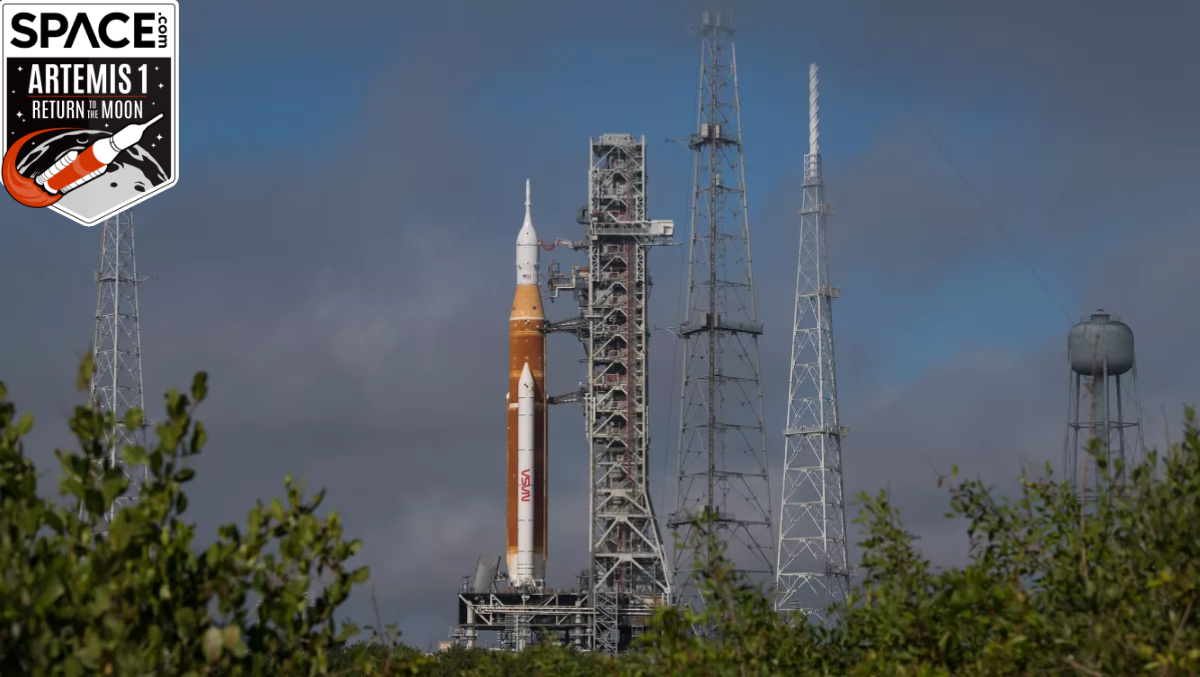
NASA's Artemis 1 moon rocket will be grounded for at least four more days.
NASA had been eyeing Sept. 23 or Sept. 27 for the launch of Artemis 1, which will use a Space Launch System (SLS) megarocket to send an Orion capsule on an uncrewed test flight to lunar orbit. But the agency announced in a blog post Monday evening (Sept. 12) that the earlier date is no longer in play; it's now targeting Sept. 27 for the Artemis 1 liftoff, with a possible backup date of Oct. 2.
Artemis 1 was supposed to be aloft already. NASA first tried launching the mission on Aug. 29 but was stymied by an anomalous temperature reading in one of the SLS' first-stage RS-25 engines. The mission team soon traced that issue to a faulty temperature sensor and got the SLS and Orion ready for another try on Sept. 3. But a leak of liquid hydrogen propellant scuttled that liftoff attempt as well.
Related: NASA's Artemis 1 moon mission: Live updates
More: NASA's Artemis 1 moon mission explained in photos
The leak occurred at a "quick disconnect," an interface linking the SLS core stage with a propellant line coming from the rocket's mobile launch tower. The Artemis 1 team replaced two seals around the quick disconnect last week and wrapped up other repair work related to the issue over the weekend, NASA officials wrote in the update.
NASA is now gearing up for an SLS fueling test, which will pump supercold propellant into the SLS to show that the leak has indeed been fixed. The agency had been targeting Sept. 17 for that test, but it has now been pushed back to no earlier than Sept. 21.
"The updated dates represent careful consideration of multiple logistical topics, including the additional value of having more time to prepare for the cryogenic demonstration test, and subsequently more time to prepare for the launch," NASA officials wrote in Monday's blog post. "The dates also allow managers to ensure teams have enough rest and to replenish supplies of cryogenic propellants."
Get the Space.com Newsletter
Breaking space news, the latest updates on rocket launches, skywatching events and more!
The Artemis 1 stack remains at Pad 39B at NASA's Kennedy Space Center in Florida, but it may end up having to roll back to KSC's huge Vehicle Assembly Building (VAB). The U.S. Space Force, which oversees the Eastern Range for rocket launches, certified Artemis 1's flight termination system (FTS) for just a 25-day stretch — and that time is already up.
NASA has requested an extension for the certification of the FTS, which is designed to destroy the Artemis 1 stack if it veers off course during liftoff. If that request is denied, the vehicle will have to be rolled off Pad 39B to the VAB, the only place where the testing required for recertification can take place. (Artemis 1 might have to go back to the VAB for repairs anyway, if the fixes made at the pad don't end up sticking.)
"NASA is continuing to respect the Eastern Range’s process for review of the agency’s request for an extension of the current testing requirement for the flight termination system and is providing additional information and data as needed," NASA wrote in Monday's update. "In parallel, the agency is continuing preparations for the cryogenic demonstration test and potential launch opportunities, should the request be approved."
NASA has already received one such FTS extension, from 20 days to 25 days.
The two upcoming liftoff dates for Artemis 1 are close to that of SpaceX's Crew-5 astronaut mission for NASA, which is scheduled to launch toward the International Space Station from KSC's Pad 39A on Oct. 3.
"Teams are working the upcoming commercial crew launch in parallel to the Artemis 1 planning, and both launch schedules will continue to be assessed over the coming weeks," NASA officials wrote in Monday's update.
Mike Wall is the author of "Out There" (Grand Central Publishing, 2018; illustrated by Karl Tate), a book about the search for alien life. Follow him on Twitter @michaeldwall. Follow us on Twitter @Spacedotcom or on Facebook.
Join our Space Forums to keep talking space on the latest missions, night sky and more! And if you have a news tip, correction or comment, let us know at: community@space.com.

Michael Wall is a Senior Space Writer with Space.com and joined the team in 2010. He primarily covers exoplanets, spaceflight and military space, but has been known to dabble in the space art beat. His book about the search for alien life, "Out There," was published on Nov. 13, 2018. Before becoming a science writer, Michael worked as a herpetologist and wildlife biologist. He has a Ph.D. in evolutionary biology from the University of Sydney, Australia, a bachelor's degree from the University of Arizona, and a graduate certificate in science writing from the University of California, Santa Cruz. To find out what his latest project is, you can follow Michael on Twitter.
